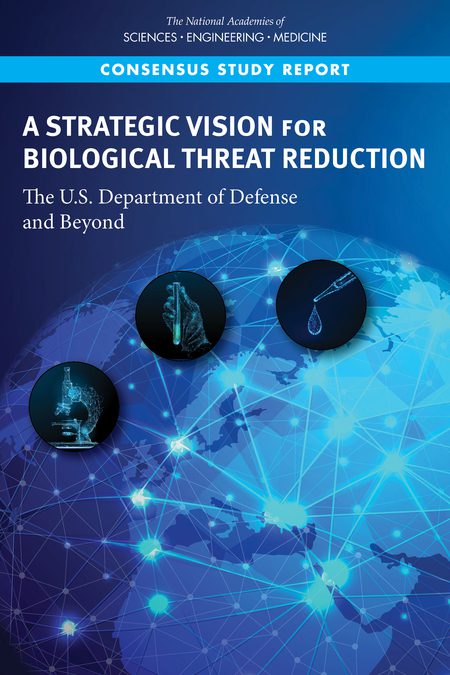A new report from the National Academies of Sciences, Engineering, and Medicine (NASEM) provides a five-year strategic vision for the U.S. Department of Defense’s Biological Threat Reduction Program (BTRP) to expand its leadership in the federal government’s development of an enduring interagency mechanism to address an array of biological threats — including natural disease outbreaks, accidental releases, and intentional attacks — to deployed U.S. forces and to the nation itself.
The report recommends that BTRP — which has a long history of engaging with other nations to promote professional and technical capabilities to address current and future biological risks — be given greater geographic and programmatic flexibility, enabling it to engage in geographic regions before situations become critical, and to address a broader range of potential threats than traditionally recognized.
Because BTRP is just one of several U.S. government programs conducting international health security engagement, the strategic vision and success of the program rely on coordinating actions with the U.S. government as a whole — including agencies such as the U.S. Agency for International Development, the Centers for Disease Control and Prevention, the U.S. Department of State, among others — and with its international partners. An interagency mechanism is needed to coordinate the federal government’s efforts to identify and respond to various biological threats, the report says.
The report, the product of a two-year study, was finalized in January, as reports were emerging of the novel coronavirus that has since caused a global pandemic.
“The COVID-19 pandemic has shown the devastating power and speed with which infectious disease can spread across the globe,“ said Gerald Keusch, co-chair of the committee that wrote the report, and professor of medicine and global health at Boston University. “It will take many U.S. programs working together, and with other governments and nongovernmental organizations, to address the challenges of emerging infectious diseases, as well as other biological threats.”
Interagency Coordinating Mechanism Needed
No single U.S. government program has or should be expected to have the authority or the capability to act on every aspect of the challenge of biothreats, the report says, but currently organizational divisions and boundaries hinder improvements in efficiency and cost-effectiveness.
To address that problem, BTRP and other agencies need to be part of a durable interagency coordination mechanism that addresses the full set of biological threats and risks, using the agency best suited to each task, the report says. An effective mechanism will have greater geographic flexibility and will demonstrate better awareness, prevention of threat development, and more timely response.
The interagency mechanism should draw upon on medical, military, diplomatic, scientific, and other expertise — from across the federal government and beyond it — to address natural, accidental, and intentional biological threats and risks to deployed forces and to the nation. It should enable effective partnerships across U.S. government agencies; with NGOs, the private sector, and academia; and with other nations.
Over the next five years, the report says, BTRP should encourage, support, and help co-lead the U.S. government’s development of this coordinating mechanism.
Action Should be Taken to Increase BTRP’s Flexibility, Scientific Expertise
BTRP establishes critical lines of communication about biological risks and threats, from any origin, with partner governments and responsible individuals, the report notes. The program also supports operational and situational awareness in areas where it can operate and invests in building capacity that improves biosecurity, ultimately providing additional security to the United States.
“The kind of engagement BTRP conducts promotes individual relationships of trust, which can contribute to trust and understanding among leaders in ministries and governments,” said committee co-chair David Franz, independent consultant and former commander of the U.S. Army Medical Research Institute of Infectious Diseases. When an outbreak occurs — whether natural, accidental, or deliberate in origin — in a country where BTRP is engaged, such relationships can cut through the chaos of the moment and streamline the rapid implementation of a healthcare and containment response, the report says.

The report offers a series of recommendations to enable the program to carry out its role more effectively, including being given greater geographic flexibility, which is essential for effective and efficient implementation of bioengagement efforts. Currently, the program is constrained by policy and geographic requirements that inhibit its ability to respond nimbly to emergent threats.
The Office of the Secretary of Defense for Policy should seek a global determination from Congress, which would give BTRP authority and flexibility to work when and where national biosecurity needs — and diplomatic opportunities — are identified or reasonably anticipated. In addition, the Defense Threat Reduction Agency — of which BTRP is a part — should give BTRP as much programmatic flexibility as possible to understand and broadly address the current and anticipated biosecurity and biosafety needs of each country where it engages.
The report recommends that the Office of the Secretary of Defense for Policy, together with BTRP, monitor and identify likely future potential infectious disease vulnerabilities in the changing threat landscape. As a part of this forward assessment process, BTRP should identify opportunities to bolster local partner countries’ capabilities to detect aberrations from the norm early in an event or outbreak in order to better anticipate events through improved surveillance and analytical capacity.
In addition, the report urges BTRP to acquire greater scientific expertise on its staff and proactively engage with the broader scientific community to better understand technical and scientific developments in emerging infectious diseases.
A Strategic Vision for Biological Threat Reduction: The U.S. Department of Defense and Beyond (2020). National Academies of Sciences


